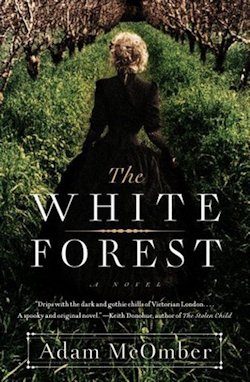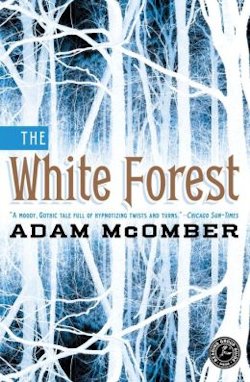I’ve never been a particularly religious person, but even I am struck, sometimes, with the conviction that there must be more to the world than this. Some power greater than ours.
I don’t mean to say that the world is not enough—that would make me the Bond villain of bloggers, after all. Nor do I intend to imply that the power people wield is at all paltry—to be sure, that too would be very far from the truth. But in the face of nature’s creations, not to mention its infinite variations, it’s hard to avoid being awed, is it not?
Be that as it may, I am content to live in a wonderful world and know that it is so, yet many demand more. To each their own, of course; I wouldn’t dare discriminate! But from time to time, men like Ariston Day emerge from the many aforementioned. The antagonist of Adam McOmber’s darkly fantastic first novel believes with every fibre of his being that there is somewhere a door to be opened; a membrane, maybe, to be teased—or torn—apart. And Day is determined to do so. At any conceivable cost.
The charismatic leader of a sensational sect known as the Theatre of Provocation, which has its headquarters deep beneath a tavern called the Temple of the Lamb, Day exists primarily on the periphery of McOmber’s magnificently measured debut. His tempestuous presence, however, is felt from the first.
That’s not the case for our narrator, Jane Silverlake, who has lived a lonely life. At once shunned by the poor and rejected by the rich, she seems set aside from society entirely at a time and a place, specifically Victorian-era England, which values nothing else as highly. To make her existence still more maudlin, she’s been haunted by objects ever since losing her mother to an eerie fever—an uncanny talent that takes a telling turn during The White Forest’s first act. Rather than simply singing to her, the things she sees start to speak; if not in words then courtesy increasingly crystalline images:
It was as if every object had become a curtain, and behind that curtain lay a new realm. The realm was not of simple colour and sound—it was an actual place. Had I read any of the burgeoning literature of scientific fiction, I might have called the place a “parallel dimension,” but I had no word for what I saw. It was a landscape—a white forest, pale as paper, clearly a vision of some alien landscape. In the forest there was a stream of milk-white water that did not flow but remained still, as if frozen. There were flowers in the undergrowth—blossoms that appeared to be lit from within, like Chinese lanterns. I recognised the place. As a child, I’d seen it in dreams inside the mouths that opened in Mother’s flesh.
Jane tries to keep these surreal experiences a secret, but when she is befriended—quite out of the blue—by a beautiful young woman, Miss Madeline Lee, and a dashing gentleman-in-the-making named Nathan Ashe, her abilities inevitably become apparent. A powerful bond forms between the three thereafter, brought on by this shared knowledge, and the years elapse happily.
For a long while, we triangulated, and there was energy in that. I sometimes felt myself to be the center of our group, a project for both of them. It wasn’t until Nathan discovered the Empyrean itself that everything truly got out of hand. The triangle was broken by that strange vision, and it was then that we began our free fall.
Nathan’s fascination with the Empyrean ultimately leads him into the arms of Ariston Day… and then he disappears completely. Quite literally, he is lost. An Inspector Vidoq—the model for the main character of many of Edgar Allen Poe’s most notable short stories—is called in to investigate this locked room mystery of sorts, but Jane and Maddy only cooperate with Vidoq to a point. To preserve the sanctity of the secret they share, the ladies resolve to unravel the strange circumstances surrounding their dear heart’s vanishing act themselves.
Little do they realise where the case will take them, and how it is bound to break them.

The White Forest has an absorbing plot, compelling characters and an exceptionally well-rendered setting, assuming you can get past a few factual and geographical inaccuracies, meanwhile McOmber imparts an abundance of exquisite imagery in pristine prose that often comes close to poetry. Little about this book is anything less than impeccable, in fact—let me state, out of the gate, that it’s great; positively phenomenal for a first novel—but what impressed me most about The White Forest was its incremental descent into dark fantasy.
At the outset, the author plays it perfectly straight. His Hampstead Heath feels nearly real. His lords and ladies are far from the caricatures that tend to populate these sorts of novels; they’re authentic individuals, flawed and self-absorbed, but not tortured or hysterical or wholly heroic. Our central characters are similarly convincing, which is to say, for all that they’re the good guys, they do some despicable things.
In short, it’s all awfully ordinary. But the extraordinary is never far away. Even the banality of the beginning is punctuated by moments of sudden, shattering violence. Confronted by Maddy’s beauty in a mirror, for instance, Jane wonders:
What would it feel like […] to crack the brush against her skull? An awful notion. She was mine, and I was hers. And yet she had a lovely face— I could not stop myself from thinking this —certainly lovelier than my own. But what did Nathan think? A horrid question. If Nathan ever chose one of us, the fantasy would be broken. Flood-waters would rise.
And indeed they do.
But these are only isolated moments, initially. By the end, however, the unknowable notions that formerly suffused the fringes of the fiction have supplanted its earlier reality entirely; the last chapters don’t even take place on our planet! Suddenly The White Forest is like Lovecraft come Among Others, Caitlin R. Kiernan meets The Croning, yet somehow McOmber makes the whole his own.
At once weird and wonderful, The White Forest is an uncanny confluence of magic and mystery, and over its controlled course, Adam McOmber paints a picture both beautiful and terrifying, exhibiting his mastery of both the fantastical and the practically factual. To come full circle, The White Forest is the sort of book that makes one wonder whether there mightn’t be something more to the world than we’re aware of, and it’s my pleasure to recommend it unreservedly.
The White Forest is published by Touchstone. It is available now in the US and will be released July 9th in the UK.
Niall Alexander is an erstwhile English teacher who reads and writes about all things weird and wonderful for The Speculative Scotsman, Strange Horizons, and Tor.com, where he contributes a weekly column concerned with news and new releases in the UK called the British Genre Fiction Focus, and co-curates the Short Fiction Spotlight. On rare occasion he’s been seen to tweet, twoo.










